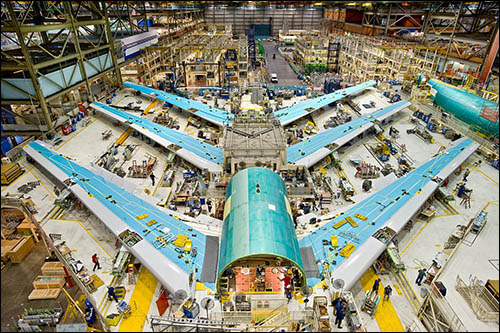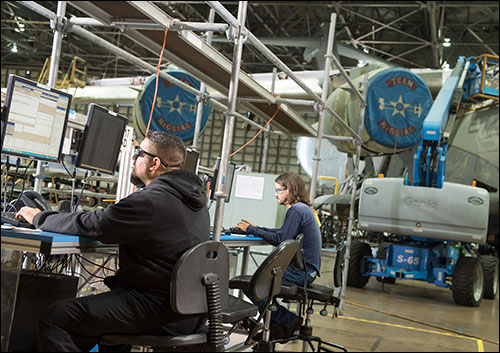A year after launching an enterprise-wide Internet of Things (IoT)-based solution to capture and manage radio frequency identification and other sensor data at 50 Boeing assembly sites, San Diego-based software company Tapestry Solutions is marketing a commercial version of the system. The new version, called Enterprise Sensor Integration (ESI), is aimed at large companies across multiple industries.
At Boeing, the existing solution—which it calls the Automated Identification Technology – Information Management System (AIT-IMS)—manages all data collected from more than 1,000 different sensor devices, such as readers, receivers and access points across the aerospace company’s U.S. sites. The data being centrally managed on Boeing’s server comes from both passive and active RFID readers, as well as from GPS technology and multiple software platforms, so that users can access data regarding assets, work in progress (WIP) and materials at numerous sites.

The newly released ESI system is a scalable software platform intended for use across a company’s entire enterprise, says Mike Spencer, Tapestry Solutions’ VP of global sales and marketing. It is sensor-agnostic, meaning it can manage data from all varieties of RFID readers, including ultrahigh-frequency (UHF), high-frequency (HF) and active RFID, as well as Wi-Fi networks and other sensors. ESI, which can be cloud-based or reside on a user’s own server, integrates all data streams and allows users to not only locate items, but also receive alerts and conduct analytics.
Tapestry Solutions has provided sensor-based middleware to the U.S. Department of Defense for years. The company caught Boeing’s attention in 2008 when the aerospace firm was seeking a system to manage the many independent RFID- and other sensor-based systems installed at its sites worldwide. Boeing acquired Tapestry Solutions that same year, and in 2013 it began integrating its systems with AIT-IMS. Boeing and Tapestry Solutions then spent two years deploying the solution across the entire global enterprise. The technology has been live since 2014.
Before the AIT-IMS technology was implemented, Spencer says, “Boeing had a big problem—and it’s a problem a lot of companies have.” The company has thousands of assets distributed around the globe, most of which are high in value. Boeing had established dozens of systems—using multiple types of sensors, both RFID and otherwise—but few were integrated. “Boeing asked us to build a solution that integrates data from a variety of sensors, RFID readers and software platforms.”
Tapestry Solutions worked with Boeing’s commercial airplane, defense, space and security divisions. The resulting system, Spencer says, was based on similar solutions provided for the U.S. military and had to accommodate a variety of hardware types. “Boeing had different types of RFID systems that were better for different processes,” he explains. For instance, various assets and materials require a variety of RFID, ultra-wideband (UWB) or Wi-Fi tags.
Some use cases only required portal-based location data (such as capturing tag IDs as objects passed through a dock door), while others demanded that the software capture each item’s every movement. Sensor data can also be required in some parts of Boeing’s operations. For example, if epoxy is being applied to a component during assembly, the company needs to monitor the temperatures at which components and epoxies have been exposed—and, in some cases, how long a particular tool has been used, when it was calibrated and who used it. The AIT-IMS solution captures and manages this data, then uses it for analytics purposes.
Boeing’s AIT-IMS is currently managing two billion tag readers each week across all 50 sites. Boeing reported a savings of more than $100 million during its first year by reducing labor costs, increasing workflow efficiency, preventing asset theft, lowering rental equipment expenses and improving decision making based on the analytic data. Tapestry estimates a recurring savings for Boeing of $80 million annually. Boeing next intends to expand the system’s analytics functionality, Spencer says, moving beyond “Where’s my stuff?” to “What’s the status of my stuff?”—which, he adds, will enable the company to identify inefficiencies and take corrective measures.
“We believe AIT-IMS is the only system of its kind that has been successfully rolled out at a scale of this magnitude,” says Jim Caldwell, Tapestry Solutions’ AIT-IMS program manager.
Tapestry Solutions is marketing the ESI technology as an integrated solution for health care, pharmaceuticals, aerospace, automotive, and other manufacturing and worldwide military programs. The system not only manages RFID data for location and status information, but also monitors IoT deployments, such as for thermostats, door locks, machine operation and lighting, based on sensor data. The technology is scalable, Spencer notes, so additional systems can be added to the ESI solution over time. “One of the things that’s powerful is the development platform,” he says, which enables users to build interfaces for a wide variety of applications, as well as for analytics purposes.
Tapestry Solutions is presently in discussions with several foreign military organizations, in addition to companies in the health-care, automotive, pharmaceutical and manufacturing industries.




